Vining plants are some of the most beautiful kinds of plants you can grow. The way they look climbing your trellis or posts looks like something out of a fairytale.
Likely, you want to grow plants that are easy to grow with minimal work. Thankfully, there is an abundance of vining plants that are easy to grow at home.
Vining plants may look intimidating – after all, they can grow to large sizes and span the height of a building. In reality, many vining plants are a simple grow-project that anyone can tackle in their own backyard.
Vines That Are Easy to Grow Fast
If you’re looking for some fast growing flowering vines, here is a list of vine plants you can choose:
Clematis
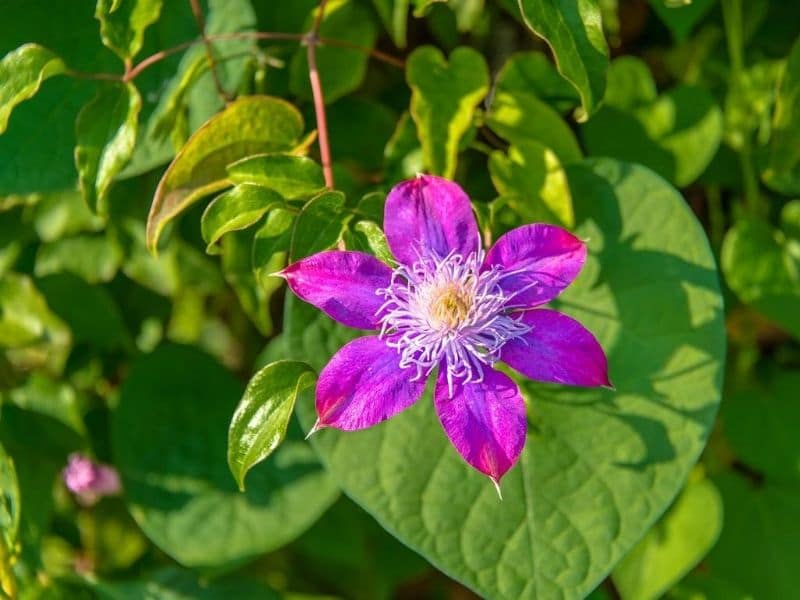
Clematis plants are some of the fastest-growing vines and will provide optimal coverage in a short amount of time.
Clematis are very versatile, and it doesn’t take much to encourage them to grow. Sunny locations are ideal for many clematis types to grow to its full potential, but partially shady areas should also suffice.
Wisteria
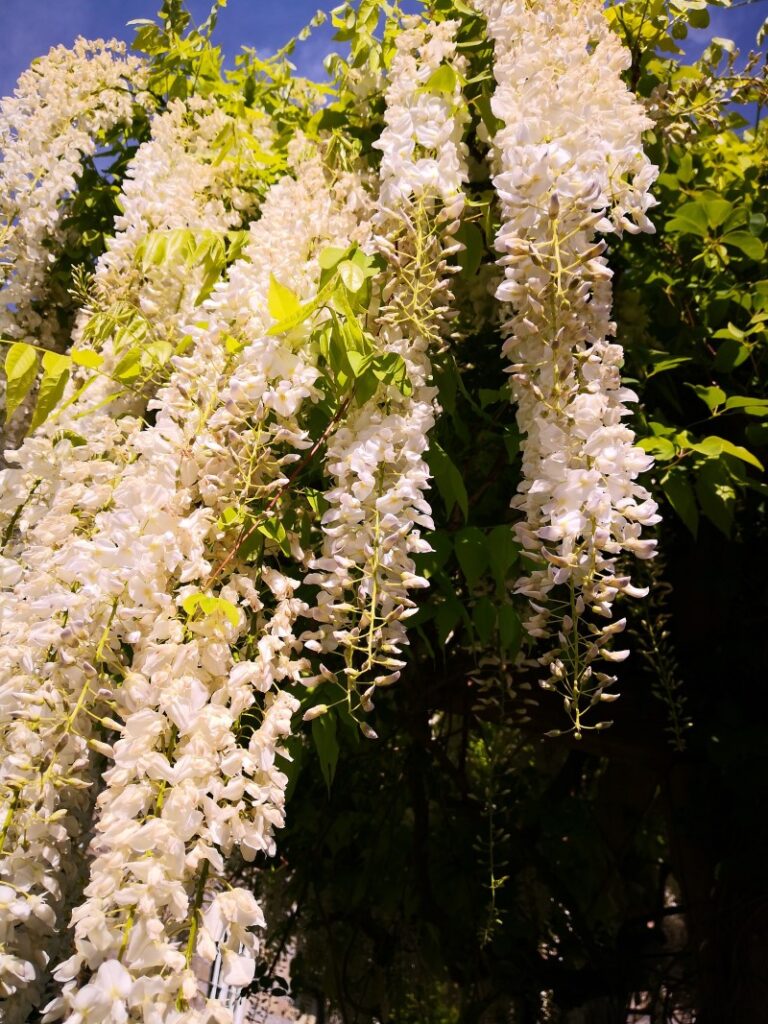
Wisteria is another flowering vine that can reach great heights, generally around 30 feet. Wisteria is a very hardy vine that doesn’t require much help when it comes to growing.
In fact, wisteria vines will grow anywhere they can reach, and occasionally take over other plants. If you are looking for a vine to cover a fence or trellis, wisteria will get the job done with little effort.
Trumpet Vine

Trumpet Vine (Campsis radicans), also known as Trumpet Creeper, is a vigorous and eye-catching vine plant native to North America. Renowned for its stunning trumpet shaped flowers in shades of red, orange, or yellow, it attracts pollinators like hummingbirds and butterflies.
Thriving in full sun and well-drained soil, it’s commonly used to cover fences, trellises, and arbors, adding a vibrant burst of color to landscapes.
Despite its beauty, Trumpet Vine can be invasive, spreading rapidly through underground runners, so regular pruning is necessary to keep it in check. With proper care, this striking vine creates a breathtaking display in gardens and outdoor spaces.
Boston Ivy
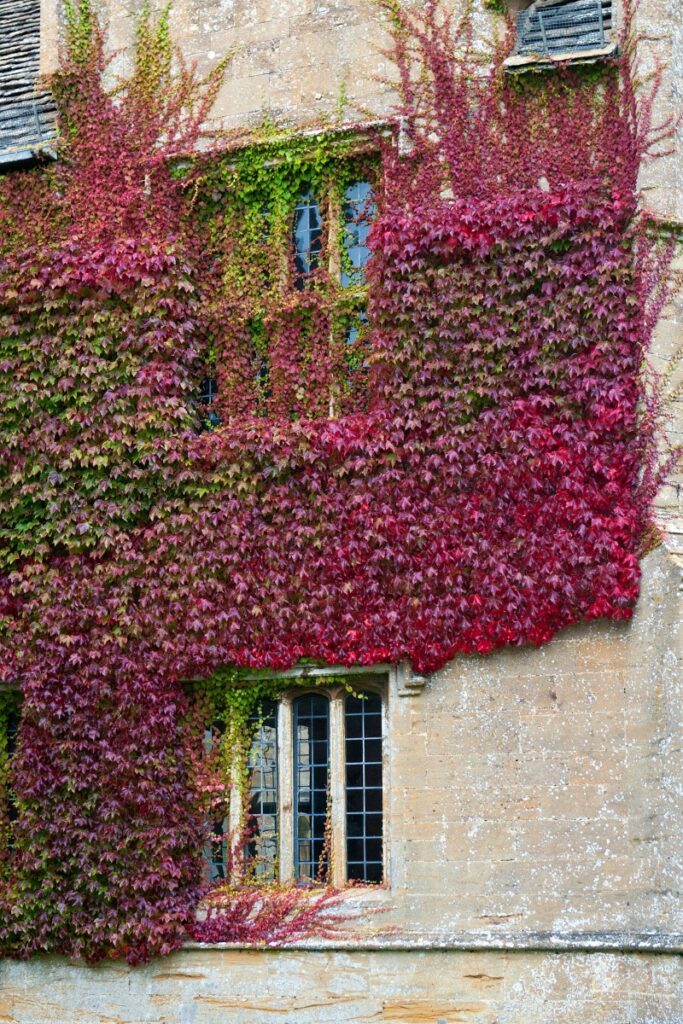
If you want a tropical vine that will grow up nearly any surface, Boston ivy may be a good choice. Its leaves are green in the summer months, and turn a nice reddish color in the fall.
Boston Ivy is known for climbing the sides of buildings, particularly brick buildings where there are small ledges to cling to. Boston Ivy requires little to no care to grow, but you may need to keep it trimmed back if there are certain areas where you don’t want it growing.
English Ivy

English Ivy is another vine that is easy to grow at home. English Ivy is evergreen, so it will provide nice green leaves and cover all-year-round.
English Ivy is not only known for its vertical vining but for its ability to cover large areas of ground as well. English ivy vines have been known to grow out of control, but with some trimming, they are a very easy vine to grow.
Chocolate Vine
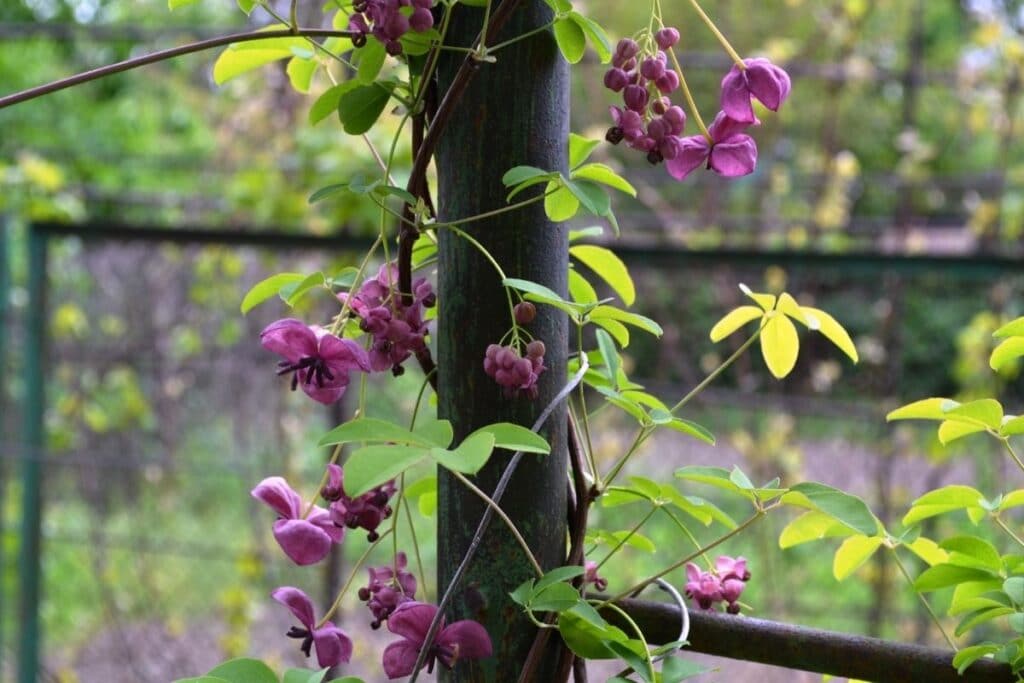
Chocolate Vine (Akebia quinata) is a captivating perennial vine plant known for its lush foliage and fragrant, chocolate-scented flowers.
Native to East Asia, it thrives in temperate climates and is valued for its rapid growth and ability to cover fences, trellises, and arbors. Featuring distinctive five-leaflet leaves and clusters of unique purplish-brown blooms in early spring, it adds a touch of exotic beauty to gardens.
Chocolate Vine is relatively low-maintenance, requiring occasional pruning to control its growth and prevent it from becoming invasive. Its ornamental appeal and sweet aroma make it a delightful choice for adorning vertical spaces in landscapes.
Climbing Hydrangea
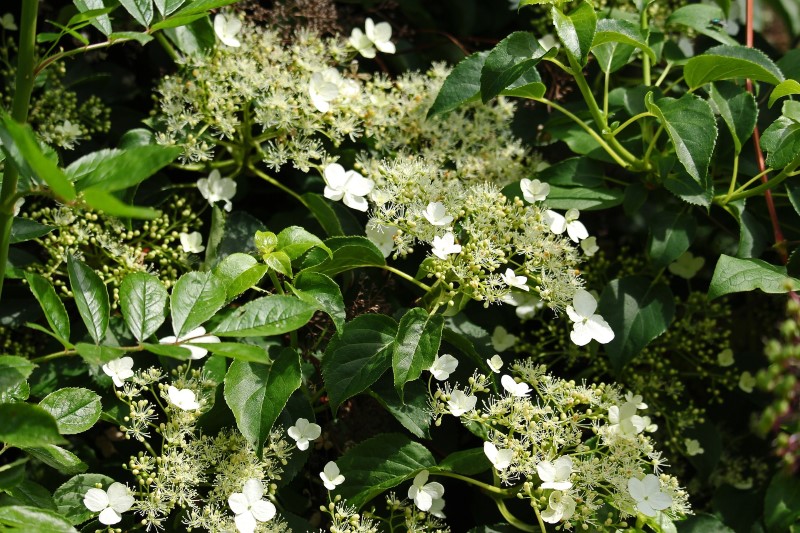
Climbing Hydrangea (Hydrangea anomala subsp. petiolaris) is a charming vine plant admired for its lush foliage and clusters of delicate white flowers.
Originating from East Asia, it thrives in partial to full shade and moist, well-drained soil, making it an ideal choice for shaded areas of gardens.
This vigorous climber attaches itself to surfaces using aerial roots, gracefully adorning walls, fences, and trees with its verdant leaves and abundant blooms.
This climbing vine is prized for its ability to provide both ornamental beauty and natural privacy screening, enhancing flower production and making it a beloved addition to landscapes seeking a touch of elegance and tranquility.
Morning glory
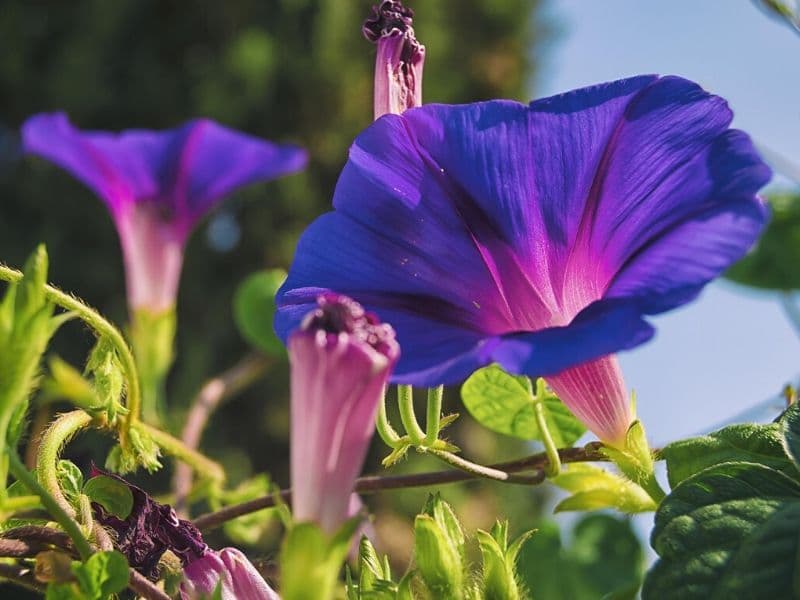
Morning glory (Ipomoea) is a captivating and fast-growing vine that graces gardens with its vibrant blooms. These frost-tender, perennial vines quickly envelop trellises, creating a lush display.
Their trumpet-shaped flowers open early in the morning, hence the name. Morning glories come in an array of colors, from serene blues to delicate pinks and regal purples.
Bees, butterflies, and hummingbirds are irresistibly drawn to these annual vine blossoms, making them a delightful addition to any garden.
Climbing Roses
Climbing roses are enchanting additions to any garden, their vibrant blooms scaling trellises, walls, and arbors with grace. These hardy plants combine beauty with resilience, making them a favorite among gardeners. Let’s explore a few captivating climbing rose varieties:
- Altissimo (Rosa ‘Altissimo’): With velvety, bright red petals and showy yellow stamens, Altissimo is disease-resistant and long-blooming.
- American Beauty (Rosa ‘American Beauty’): This deep, cupped dark pink rose thrives even in shade. Its long canes are ideal for training against walls or trellises.
- Cécile Brunner (Rosa ‘Cécile Brunner’): A romantic heirloom rose, Cécile Brunner produces petite clusters of blush-pink flowers with a sweet, spicy scent.
Grape Vine
Grapevines (Vitis vinifera) are captivating climbers that naturally thrive on trees and bushes, spreading their tendrils high and wide. In vineyards, meticulous pruning ensures control over grape quantity and quality.
This woody vine requires full sun to produce fruit. Each vine demands about 6 feet of space, and their flowers and fruit emerge from new shoots called canes. Remarkably, you can enjoy fruit just one year after planting.
Wind and insects pollinate the delicate flowers, leading to the development of luscious grapes. Whether for wine production or culinary delights, grapevines enrich our lives and landscapes.
Types of Vines
There are three main types of vines when it comes to the way they climb.
The first, twining vines, do best when growing on poles or other thin structures.
Next are tendril vines, which shoot off thin, almost string-like, tendrils that grab onto anything they can find and establish growth in those directions.
Last are clinging vines, which use above-ground roots to cling to straight surfaces, such as building walls.
How To Grow and Care for Vines
Here are some important things you need to know when it comes to growing climbing vines.
Training Vining Plants
As mentioned previously, some vining plants will grow aggressively and may reach undesired areas. Some people like the look of an untamed vining plant it can add character to your home but others would prefer to keep their vines nicely manicured.
The first step in training a vining plant is to establish where you want your vines to grow. This may be on a trellis, pergola, pole, wall, fence, or other location. Wherever you want your vine to grow, you will want to plant it near the base of the desired object. Once your plant has sprouted, or if you start with a vine that is already sprouted, you can carefully start to manipulate its direction of growth.
Depending on the structure your vine is climbing, you may be able to loop the ends of the vines through holes, like with a trellis. Simply looping the ends of your vines through these slots should be enough for them to catch on and continue growing in that direction.
If your vines don’t hold or are too heavy to hold, you may need to use some twine or twist-ties to hold the ends in place while the vines take hold on their own.
Another way to train your vines is to prune off side segments to force lateral growth. By eliminating the vine segments that are growing in a direction you don’t want, the plant will put more energy into other areas of growth.
Growing Vining Plants for Privacy
One popular reason for growing vining plants is to create a privacy barrier between neighbors. Vines such as Ivy (Boston ivy, English ivy, poison ivy,…) and trumpet vine will grow quickly and can cover large areas. These are popular choices for growth on fences or trellises that divide property lines.
One note on growing vining plants to divide property lines is that you should talk with your neighbor beforehand. Many vining plants can become invasive and will grow in undesired areas. Discussing who will trim the vines back and control growth is important before planting your vining plants.
Caring for Vining Plants
One of the most important care tips for vining plants is proper pruning. As mentioned above, pruning can encourage growth in desired directions. For vertical growth, it is also recommended to pinch off new growth every 6 inches for flowering vines to encourage both height and new blooms.
Different vines are going to require different amounts of water. As a general rule, new growth will require extra water to become established. A fully established vine should not require daily watering, and should only need to be watered if there’s a long period of time without rain, or if it’s exposed to too much direct sunlight.
When choosing what vines to plant, do some quick research ahead of time to determine any sunlight exposure criteria that your desired vines may have. Know where you plan to plant your vines and plant accordingly.
Also, check these Vines With Purple Flowers and indoor vines you can grow.
FAQs
What is the easiest vine to grow?
Pothos (Epipremnum aureum) is often considered one of the easiest vines to grow. It’s tolerant of a wide range of light conditions, requires minimal watering, and is generally low-maintenance.
What is the fastest growing vine?
One of the fastest-growing vines is the trumpet vine (Campsis radicans). It can grow several feet in a single growing season under favorable conditions, such as ample sunlight and well-draining soil.
What is a vine like plant with 5 leaves?
A vine-like plant with five leaves could be Virginia creeper (Parthenocissus quinquefolia). Virginia creeper is one of the deciduous woody plants with compound leaves consisting of five leaflets. It’s known for its vigorous growth and ability to cover large areas quickly.
*Photo by depositphotos.com/dianazh







